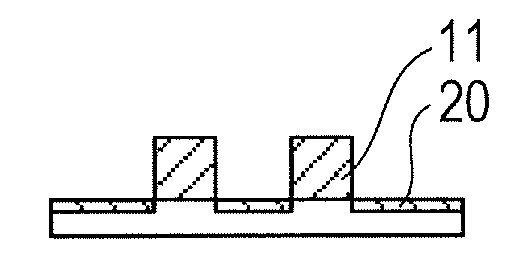Method for manufacturing photo cured material
a technology of photo cured material and manufacturing method, which is applied in the direction of electric/magnetic/electromagnetic heating, circuit masks, instruments, etc., can solve the problem of inability to precisely transfer the convexo-concave pattern of the mold to the resist film, and achieve the effect of improving the transfer precision and small surface roughness
- Summary
- Abstract
- Description
- Claims
- Application Information
AI Technical Summary
Benefits of technology
Problems solved by technology
Method used
Image
Examples
reference example 1
[0110]Firstly, mixed liquid of 4 parts by weight of polystyrene having a molar weight of 96,400 and molecular-weight dispersivity of 1.01 (produced by Polymer Source) and 96 parts by weight of propylene glycol monomethylether acetate (PGMEA, produced by Tokyo Chemical Industry CO., Ltd.) was prepared. Next, the thus prepared mixture liquid was filtered with a 0.2-μm filter made of tetrafluoroethylene, thus obtaining coating liquid.
[0111]Then, drops of this coating liquid were put on a silicon substrate, followed by spin coating at the number of revolutions of 500 rpm for 5 seconds and then of 3,000 rpm for 30 seconds, thus forming a thin film. Then, the thus formed thin film was heated on a hot plate at 90° C. for 90 seconds, whereby the silicon substrate with a polystyrene film formed thereon was obtained.
[0112]A value of surface roughness Peak to Valley (PV) of the thus obtained polystyrene film was measured using an atomic force microscope: Nanoscope produced by Veeco Instruments...
example 1
[0117]Commercially-available photo-curable composition PAK-01-60 (produced by Toyo Gosei Co. Ltd.), polystyrene and solvent are mixed, thus obtaining a photo-curable composition. Following the manufacturing processing shown in FIGS. 1A to 1G, the photo-curable composition 1 is applied on the substrate 2 and the photo-curable composition 1 is irradiated with light via the mold 4, whereby a photo cured material having a patterned shape following the convexo-concave pattern on the surface of the mold 4 is obtained.
[0118]While the present invention has been described with reference to exemplary embodiments, it is to be understood that the invention is not limited to the disclosed exemplary embodiments. The scope of the following claims is to be accorded the broadest interpretation so as to encompass all such modifications and equivalent structures and functions.
[0119]This application claims the benefit of Japanese Patent Application No. 2012-102342, filed Apr. 27, 2012, which is hereby ...
PUM
| Property | Measurement | Unit |
|---|---|---|
| rate of weight change | aaaaa | aaaaa |
| vapor pressure | aaaaa | aaaaa |
| boiling point | aaaaa | aaaaa |
Abstract
Description
Claims
Application Information
 Login to View More
Login to View More - R&D
- Intellectual Property
- Life Sciences
- Materials
- Tech Scout
- Unparalleled Data Quality
- Higher Quality Content
- 60% Fewer Hallucinations
Browse by: Latest US Patents, China's latest patents, Technical Efficacy Thesaurus, Application Domain, Technology Topic, Popular Technical Reports.
© 2025 PatSnap. All rights reserved.Legal|Privacy policy|Modern Slavery Act Transparency Statement|Sitemap|About US| Contact US: help@patsnap.com



